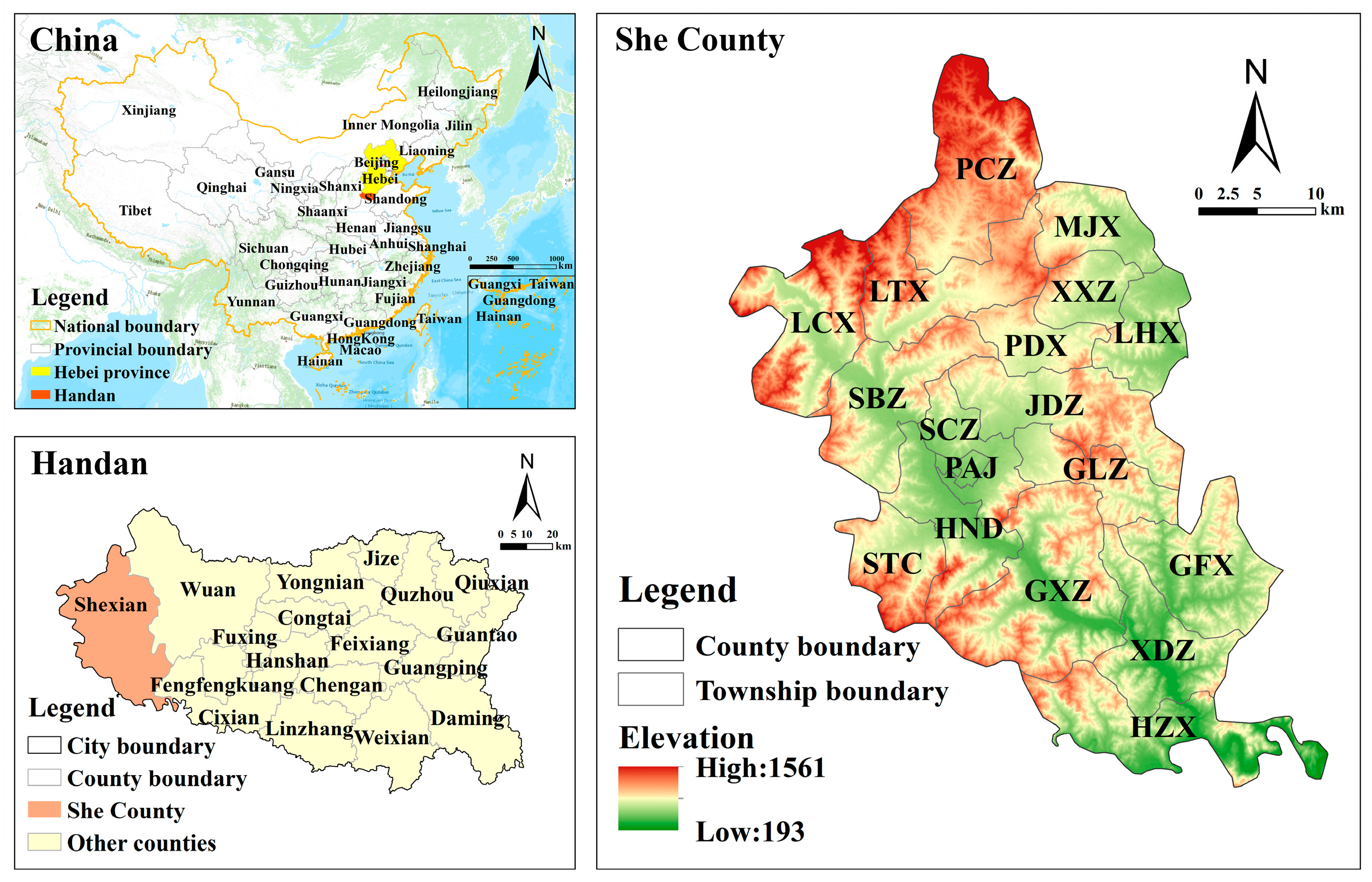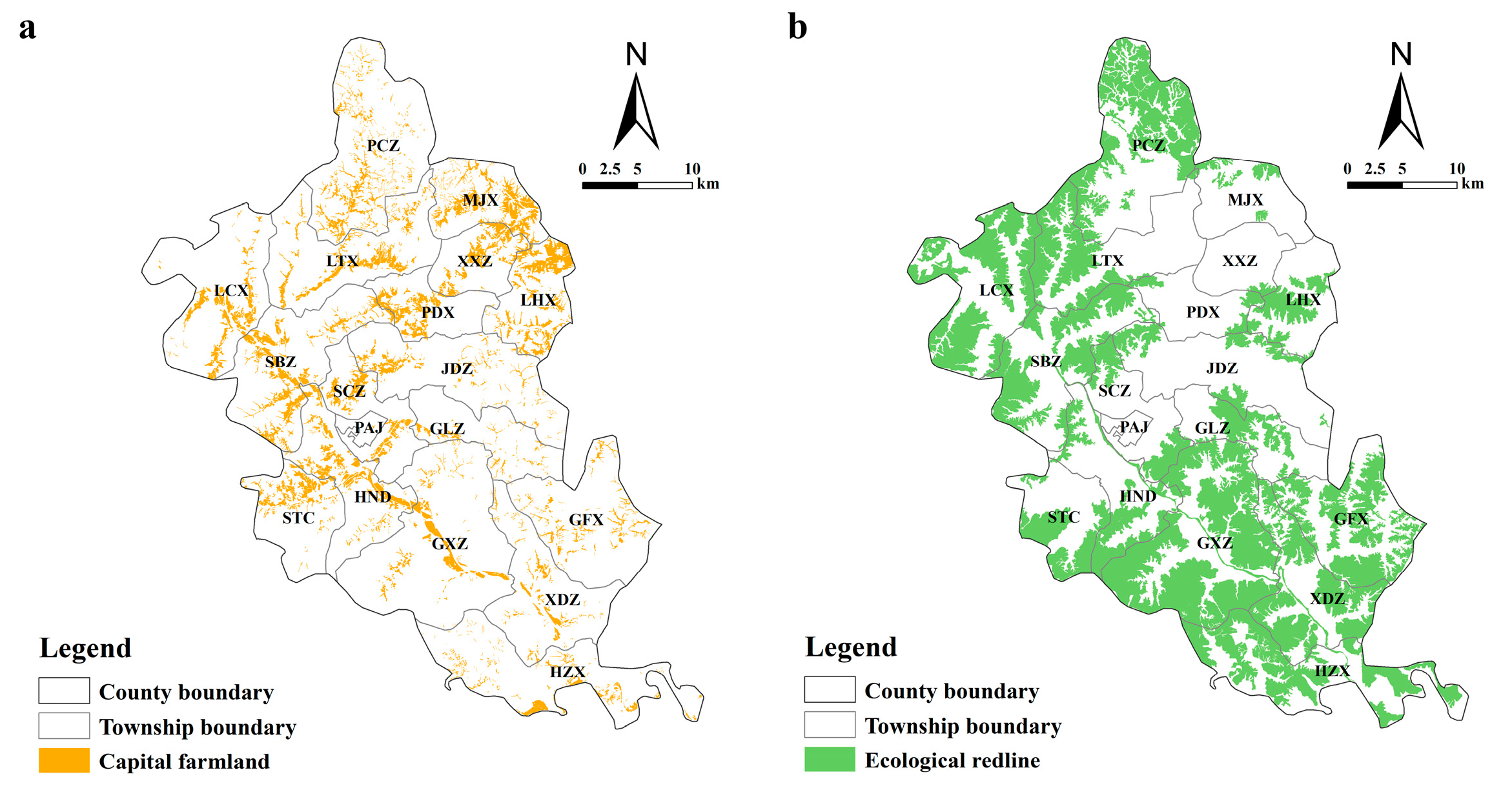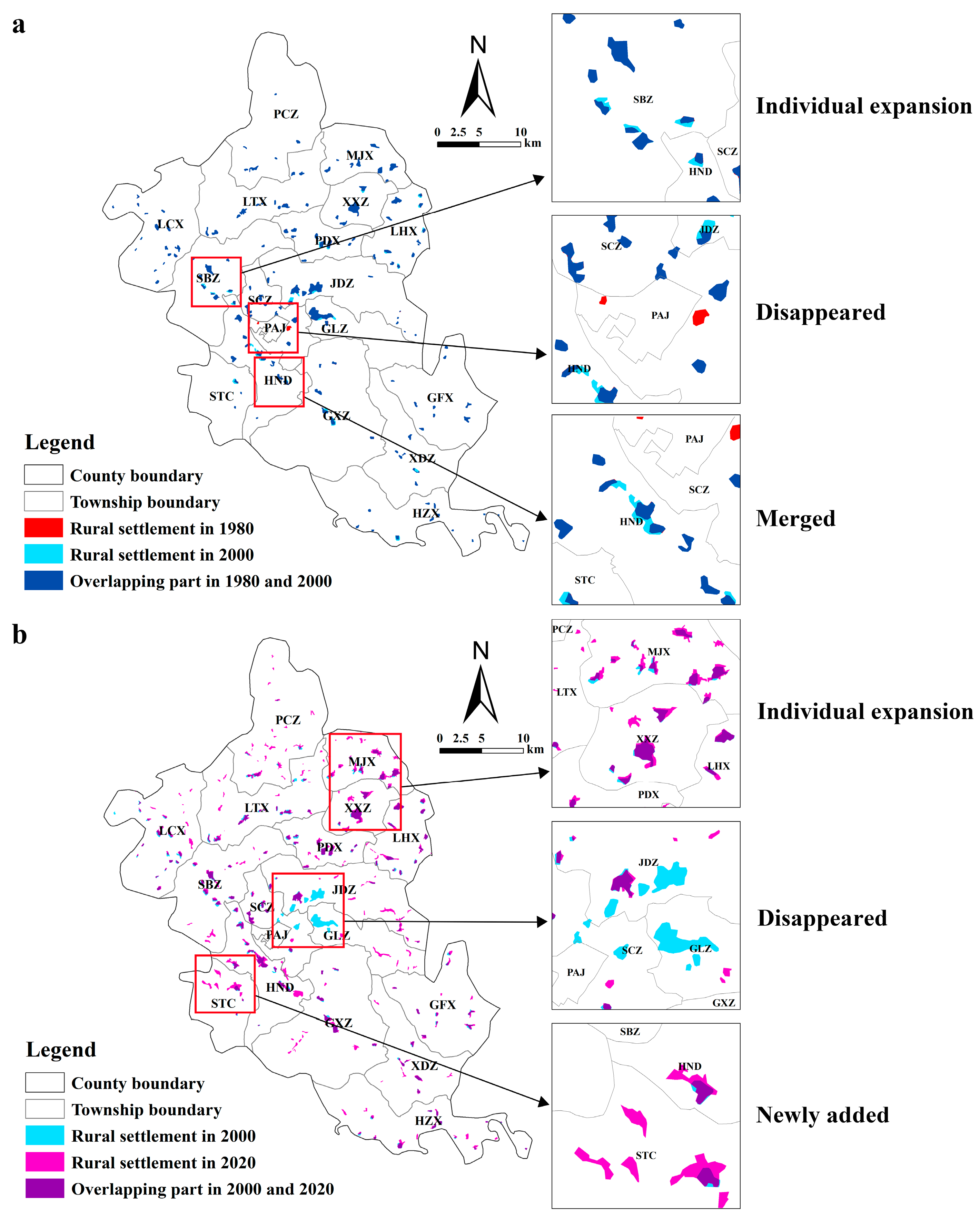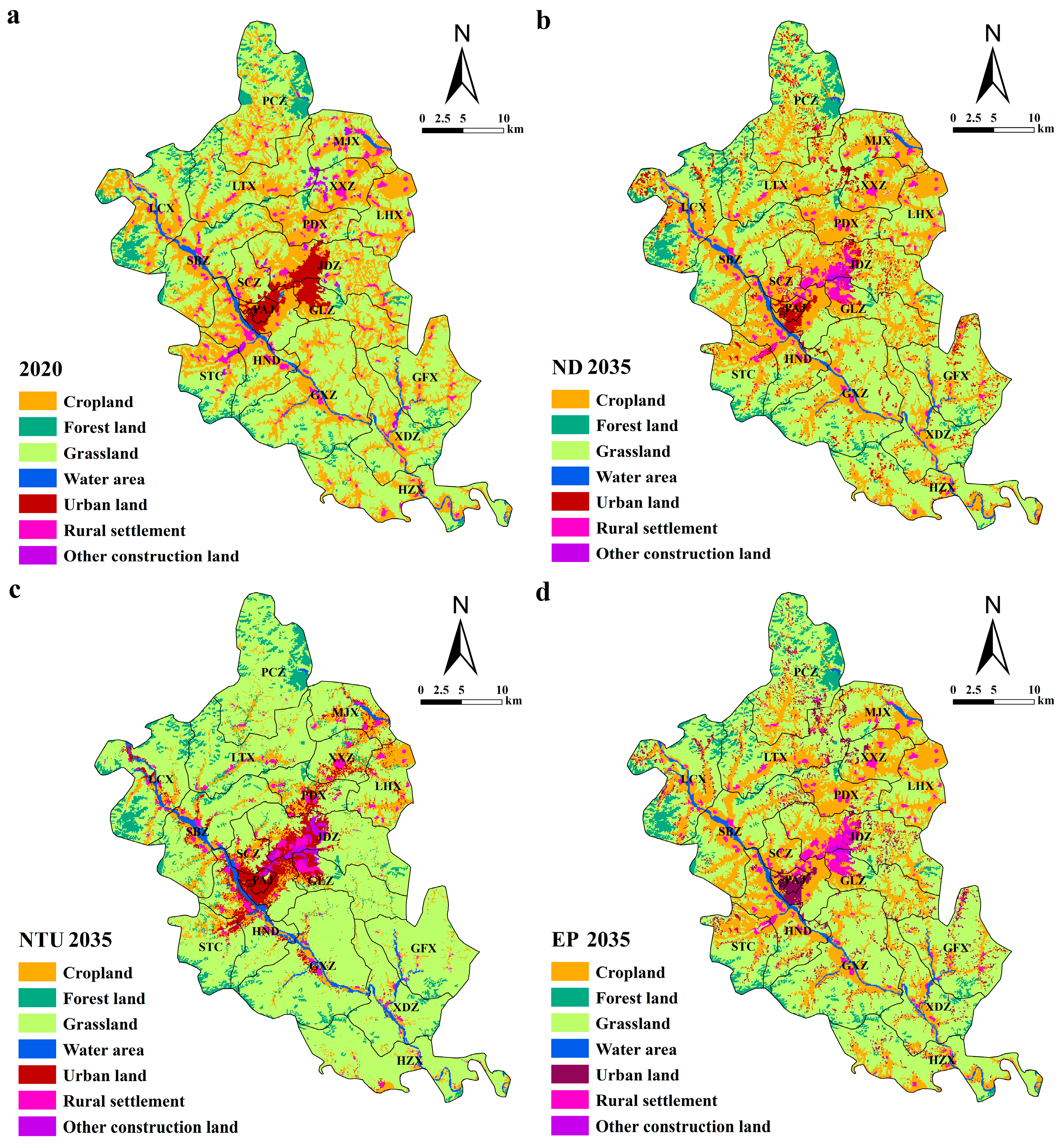The Spatial Pattern Evolution of Rural Settlements and Multi-Scenario Simulations since the Initiation of the Reform and Opening up Policy in China
Abstract
1. Introduction
2. Study Area and Data Sources
2.1. Study Area
2.2. Data Sources
3. Research Methodology
3.1. Measurement of Spatial Landscape Patterns
3.1.1. Spatial Rhythm Index
3.1.2. Average Nearest Neighbor Index
3.2. Simulating and Predicting the Spatial Evolution of Rural Settlement Patterns
3.2.1. Non-Spatial Demand Module
- (1)
- Natural Development Scenario
- (2)
- New Urbanization Scenario
- (3)
- Ecological Protection Scenario
3.2.2. Spatial Allocation Module
- (1)
- Restricted Conversion Zones
- (2)
- Driver Analysis
3.3. Spatial Iterative Computation
3.4. Evaluation of Simulation Accuracy
4. Research Results
4.1. Evolution of Rural Settlement Size from 1980 to 2020
4.2. Evolution of Spatial Patterns of Rural Settlements
4.3. Simulation of Rural Settlements
4.3.1. Verify the Accuracy of Simulation Results
4.3.2. Evolution Analysis of Rural Settlements under Multi-Scenario Simulation
4.3.3. Analysis of Rural Residential Spatial Pattern Evolution Trends
5. Discussion
5.1. Analysis of the Driving Forces behind the Spatiotemporal Evolution of Rural Residential Patterns
5.1.1. Analysis of the Driving Forces behind Rural Residential Scale Changes
5.1.2. Analysis of the Driving Forces behind the Spatial Pattern Evolution of Rural Residential Settlements
5.2. Reasons for the Evolution of Spatial Pattern of Rural Settlements under Different Scenarios
5.3. Comparison with Other Studies
5.4. Policy Implications
6. Conclusions
Author Contributions
Funding
Data Availability Statement
Conflicts of Interest
References
- Pascual, U.; Balvanera, P.; Anderson, C.B.; Chaplin-Kramer, R.; Christie, M.; González-Jiménez, D.; Martin, A.; Raymond, C.M.; Termansen, M.; Vatn, A.; et al. Diverse values of nature for sustainability. Nature 2023, 620, 813–823. [Google Scholar] [CrossRef] [PubMed]
- Pacheco, A.; Meyer, C. Land tenure drives Brazil’s deforestation rates across socio-environmental contexts. Nat. Commun. 2022, 13, 5759. [Google Scholar] [CrossRef] [PubMed]
- Martin, D.A.; Andrianisaina, F.; Fulgence, T.R.; Osen, K.; Rakotomalala, A.A.N.A.; Raveloaritiana, E.; Soazafy, M.R.; Wurz, A.; Andriafanomezantsoa, R.; Andriamaniraka, H. Land-use trajectories for sustainable land system transformations: Identifying leverage points in a global biodiversity hotspot. Proc. Natl. Acad. Sci. USA 2022, 119, e2107747119. [Google Scholar] [CrossRef] [PubMed]
- Simkin, R.D.; Seto, K.C.; McDonald, R.I.; Jetz, W. Biodiversity impacts and conservation implications of urban land expansion projected to 2050. Proc. Natl. Acad. Sci. USA 2022, 119, e2117297119. [Google Scholar] [CrossRef] [PubMed]
- Obersteiner, M.; Walsh, B.; Frank, S.; Havlik, P.; Cantele, M.; Liu, J.G.; Palazzo, A.; Herrero, M.; Lu, Y.L.; Mosnier, A.; et al. Assessing the land resource-food price nexus of the Sustainable Development Goals. Sci. Adv. 2016, 2, e1501499. [Google Scholar] [CrossRef]
- Carpio, A.; Ponce-Lopez, R.; Lozano-García, D.F. Urban form, land use, and cover change and their impact on carbon emissions in the Monterrey Metropolitan area, Mexico. Urban Clim. 2021, 39, 100947. [Google Scholar] [CrossRef]
- Newbold, T.; Hudson, L.N.; Hill, S.L.L.; Contu, S.; Lysenko, I.; Senior, R.A.; Borger, L.; Bennett, D.J.; Choimes, A.; Collen, B.; et al. Global effects of land use on local terrestrial biodiversity. Nature 2015, 520, 45–50. [Google Scholar] [CrossRef]
- Kalnay, E.; Cai, M. Impact of urbanization and land-use change on climate. Nature 2003, 423, 528–531. [Google Scholar] [CrossRef]
- Sheng, S.; Song, W.; Lian, H.; Ning, L. Review of urban land management based on bibliometrics. Land 2022, 11, 1968. [Google Scholar] [CrossRef]
- Li, H.; Song, W. Evolution of rural settlements in the Tongzhou District of Beijing under the new-type urbanization policies. Habitat Int. 2020, 101, 102198. [Google Scholar] [CrossRef]
- De Paula Pereira, A.S.A.; Dos Santos, V.J.; do Carmo Alves, S.; Amaral, A.; Da Silva, C.G.; Calijuri, M.L. Contribution of rural settlements to the deforestation dynamics in the Legal Amazon. Land Use Policy 2022, 115, 106039. [Google Scholar] [CrossRef]
- Sémécurbe, F.; Tannier, C.; Roux, S.G. Applying two fractal methods to characterise the local and global deviations from scale invariance of built patterns throughout mainland France. J. Geogr. Syst. 2019, 21, 271–293. [Google Scholar] [CrossRef]
- Tomao, A.; Quaranta, G.; Salvia, R.; Salvati, L.; Cividino, S. Neighbours matter: A micro-scale indicator of settlement structure assessing urban dispersion and planning effectiveness. Int. Plan. Stud. 2022, 27, 267–283. [Google Scholar] [CrossRef]
- Banski, J.; Wesolowska, M. Transformations in housing construction in rural areas of Poland’s Lublin region-Influence on the spatial settlement structure and landscape aesthetics. Landsc. Urban Plan. 2010, 94, 116–126. [Google Scholar] [CrossRef]
- Aleknavicius, P.; Aleknavicius, M.; Akelaityte, S. Research of changes of rural residential areas In Lithuania. J. Archit. Urban. 2014, 38, 161–172. [Google Scholar]
- Liu, J.Y.; Kuang, W.H.; Zhang, Z.X.; Xu, X.L.; Qin, Y.W.; Ning, J.; Zhou, W.C.; Zhang, S.W.; Li, R.D.; Yan, C.Z.; et al. Spatiotemporal characteristics, patterns, and causes of land-use changes in China since the late 1980s. J. Geogr. Sci. 2014, 24, 195–210. [Google Scholar] [CrossRef]
- Ekici, S.C.; Özçakır, Ö.; Bilgin Altinöz, A.G. Sustainability of historic rural settlements based on participatory conservation approach: Kemer Village in Turkey. J. Cult. Herit. Manag. Sustain. Dev. 2022. [Google Scholar] [CrossRef]
- Balta, S.; Atik, M. Rural planning guidelines for urban-rural transition zones as a tool for the protection of rural landscape characters and retaining urban sprawl: Antalya case from Mediterranean. Land Use Policy 2022, 119, 106144. [Google Scholar] [CrossRef]
- Li, S.; Song, W. Research progress in land consolidation and rural Revitalization: Current status, characteristics, regional differences, and evolution laws. Land 2023, 12, 210. [Google Scholar] [CrossRef]
- Zhao, X.; Sun, H.B.; Chen, B.; Xia, X.H.; Li, P.F. China’s rural human settlements: Qualitative evaluation, quantitative analysis and policy implications. Ecol. Indic. 2019, 105, 398–405. [Google Scholar] [CrossRef]
- Song, W.; Li, H.H. Spatial pattern evolution of rural settlements from 1961 to 2030 in Tongzhou District, China. Land Use Policy 2020, 99, 105044. [Google Scholar] [CrossRef]
- Topole, M.; Bole, D.; Petek, F.; Repolusk, P. Spatial and functional changes in built-up areas in selected slovene rural settlements after 1991. Acta Geogr. Slov. Geogr. Zb. 2006, 46, 190–226. [Google Scholar] [CrossRef]
- Nandi, S.; Mistri, T. Transformation of rural settlement in Salanpur community development block, West Bengal, India. GeoJournal 2023, 88, 291–318. [Google Scholar] [CrossRef]
- Alphan, H.; Karamanli, E.; Derse, M.A.; Uslu, C. Analyzing pattern features of urban/rural residential land use change: The case of the southern coast of Turkey. Land Use Policy 2022, 122, 106348. [Google Scholar] [CrossRef]
- Ntassiou, K. Studying abandoned settlements’ renaissance in the context of rural geography: Perspectives for Prespes, Greece. Eur. Plan. Stud. 2022, 30, 359–383. [Google Scholar] [CrossRef]
- Çağlıyan, A.; Dağlı, D. Monitoring land use land cover changes and modelling of urban growth using a future land use simulation model (FLUS) in Diyarbakır, Turkey. Sustainability 2022, 14, 9180. [Google Scholar] [CrossRef]
- Jenerette, G.D.; Potere, D. Global analysis and simulation of land-use change associated with urbanization. Landsc. Ecol. 2010, 25, 657–670. [Google Scholar] [CrossRef]
- Mathewos, M.; Lencha, S.M.; Tsegaye, M. Land use and land cover change assessment and future predictions in the Matenchose Watershed, Rift Valley Basin, using CA-Markov simulation. Land 2022, 11, 1632. [Google Scholar] [CrossRef]
- Kucsicsa, G.; Popovici, E.A.; Balteanu, D.; Grigorescu, I.; Dumitrascu, M.; Mitrica, B. Future land use/cover changes in Romania: Regional simulations based on CLUE-S model and CORINE land cover database. Landsc. Ecol. Eng. 2019, 15, 75–90. [Google Scholar] [CrossRef]
- Fan, M.; Shibata, H. Simulation of watershed hydrology and stream water quality under land use and climate change scenarios in Teshio River watershed, northern Japan. Ecol. Indic. 2015, 50, 79–89. [Google Scholar] [CrossRef]
- Pham, Q.B.; Chandra Pal, S.; Chakrabortty, R.; Saha, A.; Janizadeh, S.; Ahmadi, K.; Khedher, K.M.; Anh, D.T.; Tiefenbacher, J.P.; Bannari, A. Predicting landslide susceptibility based on decision tree machine learning models under climate and land use changes. Geocarto Int. 2022, 37, 7881–7907. [Google Scholar] [CrossRef]
- Teeuwen, A.S.; Meyer, M.A.; Dou, Y.; Nelson, A. A systematic review of the impact of food security governance measures as simulated in modelling studies. Nat. Food 2022, 3, 619–630. [Google Scholar] [CrossRef] [PubMed]
- Marino, D.; Palmieri, M.; Marucci, A.; Soraci, M.; Barone, A.; Pili, S. Linking flood risk mitigation and food security: An analysis of land-use change in the metropolitan area of Rome. Land 2023, 12, 366. [Google Scholar] [CrossRef]
- Sánchez-Rivero, M.V.; Alonso, I.B.; Serrano, M.V.D.; Pozas, B.M. SDG monitoring framework for rural settlements mapping interactions with the Spanish Urban Agenda. Sustain. Cities Soc. 2023, 93, 104514. [Google Scholar] [CrossRef]
- Manouchehri, F.; Bahrami, R.; Parishan, M.; Ghaderi, R. Recognizing and analysing of empowerment rural settlements with an emphasis on sustainable development (case study of Kalashi district of Javanrud county). Village Space Sustain. Dev. 2023, 4, 14. [Google Scholar] [CrossRef]
- National Development and Reform Commission Announcement on the Publication of the List of the Third Batch of National New Urbanization Comprehensive Pilot Areas. Available online: https://www.gov.cn/xinwen/2016-12/07/content_5144553.htm#1 (accessed on 20 May 2023).
- She County Natural Resources and Planning Bureau, She County National Land and Space Master Plan Draft for Public Review. 10 May 2023. Available online: http://www.shexian.gov.cn/sxxxgk/bmxx/zfxt/xzrzyhghj/202303/t20230310_1852340.html (accessed on 20 May 2023).
- Xu, X.L.; Liu, J.Y.; Zhang, S.W.; Li, R.D.; Yan, C.Z.; Wu, S.X. China Multi-Temporal Land Use Remote Sensing Monitoring Data set (CNLUCC); Resource and Environment Science Data Registration and Publication System: Beijing, China, 2018. [Google Scholar]
- Resource and Environment Science Data Center. Provincial Digital Elevation Model (DEM) 30 m Data (SRTM 30 m); Resource and Environment Science Data Center: Beijing, China, 2005. [Google Scholar]
- Xu, X.L. Watershed and River Network Dataset of China Extracted from DEM; Resource and Environment Science Data Registration and Publishing System: Beijing, China, 2018. [Google Scholar]
- CIESIN. The Spatial Distribution of Population Density in 2005, China; Columbia University: New York, NY, USA, 2018. [Google Scholar] [CrossRef]
- Xu, X.L. Spatial Distribution Grid Dataset of China’s GDP at Kilometer Scale; Resource and Environment Science Data Registration and Publishing System: Beijing, China, 2017. [Google Scholar]
- Resource and Environment Science Data Center. Spatial Distribution Data of Roads in China for Multiple Years (1995/2012/2016/2018/2020); Resource and Environment Science Data Center: Beijing, China, 2020. [Google Scholar]
- Center for International Earth Science Information Network-CIESIN-Columbia University, and Information Technology Outreach Services-ITOS-University of Georgia. Global Roads Open Access Data Set, Version 1 (gROADSv1); NASA Socioeconomic Data and Applications Center (SEDAC): Palisades, NY, USA, 2013. [Google Scholar]
- Zhong, X.; Yan, Q.; Li, G. China Long-Term Time Series Nighttime Light Dataset (2000–2020) [J/DB/OL]. Digit. J. Glob. Chang. Data Repos. 2022. [Google Scholar] [CrossRef]
- Shafie, B.; Javid, A.H.; Behbahani, H.I.; Darabi, H.; Lotfi, F.H. An analysis of the landscape structure changes as an ecological approach to achieve sustainable regional planning (case study: Latian Dam watershed). J. Environ. Eng. Landsc. Manag. 2023, 31, 9–22. [Google Scholar] [CrossRef]
- Keita, M.A.; Ruan, R.Z.; An, R. Spatiotemporal change of urban sprawl patterns in Bamako district in Mali based on time series analysis. Urban Sci. 2021, 5, 4. [Google Scholar] [CrossRef]
- Domingues, G.F.; Hughes, F.M.; dos Santos, A.G.; Carvalho, A.F.; Calegario, A.T.; Saiter, F.Z.; Marcatti, G.E. Designing an optimized landscape restoration with spatially interdependent non-linear models. Sci. Total Environ. 2023, 873, 162299. [Google Scholar] [CrossRef] [PubMed]
- Mansour, S.; Alahmadi, M.; Abulibdeh, A. Spatial assessment of audience accessibility to historical monuments and museums in Qatar during the 2022 FIFA World Cup. Transp. Policy 2022, 127, 116–129. [Google Scholar] [CrossRef]
- Kiziridis, D.A.; Mastrogianni, A.; Pleniou, M.; Tsiftsis, S.; Xystrakis, F.; Tsiripidis, I. Improving the predictive performance of CLUE-S by extending demand to land transitions: The trans-CLUE-S model. Ecol. Model. 2023, 478, 110307. [Google Scholar] [CrossRef]
- Mamanis, G.; Vrahnakis, M.; Chouvardas, D.; Nasiakou, S.; Kleftoyanni, V. Land Use Demands for the CLUE-S Spatiotemporal Model in an Agroforestry Perspective. Land 2021, 10, 1097. [Google Scholar] [CrossRef]
- Guo, J.; Song, W.; Guo, L.; Zhang, Y. Simulation of the Effects of New Urbanization Policies on Rural Settlement Changes: A Case Study of Dingzhou City, China. J. Resour. Ecol. 2020, 13, 285–298. [Google Scholar]
- Nasiakou, S.; Vrahnakis, M.; Chouvardas, D.; Mamanis, G.; Kleftoyanni, V. Land Use Changes for Investments in Silvoarable Agriculture Projected by the CLUE-S Spatio-Temporal Model. Land 2022, 11, 598. [Google Scholar] [CrossRef]
- Akin, A.; Erdogan, N.; Berberoglu, S.; Cilek, A.; Erdogan, A.; Donmez, C.; Satir, O. Evaluating the efficiency of future crop pattern modelling using the CLUE-S approach in an agricultural plain. Ecol. Inform. 2022, 71, 101806. [Google Scholar] [CrossRef]
- She County Local Records Compilation Committee. Concise Version of She County Annals; Hebei People’s Publishing House: Shijiazhuang, China, 2015. [Google Scholar]
- Wang, L. Publication of “She County Annals (1991–2011)”. China Local Chron. Alm. 2014, 1, 1. [Google Scholar]
- Sarchani, S.; Koutroulis, A.G. Probabilistic dam breach flood modeling: The case of Valsamiotis dam in Crete. Nat. Hazards 2022, 114, 1763–1814. [Google Scholar] [CrossRef]
- Karashima, K.; Ohgai, A.; Motose, A. A Spatial Simulation Model to Explore Agglutination of Residential Areas and Public Service Facilities. Int. Rev. Spat. Plan. Sustain. Dev. 2015, 3, 57–74. [Google Scholar] [CrossRef][Green Version]
- Rodriguez, E.D.; Garcia, I.G. Morphological problems in rural municipalities: Their difficult addressing through conventional urban planning tools. Ciudad. Rev. Inst. Univ. Urban. Univ. Valladolid 2021, 24, 119–144. [Google Scholar]
- Doussard, C.; Fonticelli, C. Ecologizing planning policies and practices in France: Insights from peri-urban and rural EcoQuartier certified neighborhoods. Environ. Sci. Policy 2022, 136, 588–598. [Google Scholar] [CrossRef]
- Ning, L.; Lian, H.; Niu, Y.; Sheng, S.; Gao, Z. Identification, classification and factors of contraction of urban development: A case of Gansu section of the Yellow River Basin. Arid Land Geogr. 2023, 46, 13. [Google Scholar]
- Carson, D.A.; Carson, D.B.; Argent, N. Cities, hinterlands and disconnected urban-rural development: Perspectives from sparsely populated areas. J. Rural Stud. 2022, 93, 104–111. [Google Scholar] [CrossRef]
- Amidu, M.; Mensah, J.K.; Ahenkan, A.; Bawole, J.N. Insulating highly vulnerable populations from global pandemics: The case of Ghanaian informal settlements. Cities 2023, 141, 104504. [Google Scholar] [CrossRef]
- von Seidlein, L.; Alabaster, G.; Deen, J.; Knudsen, J. Crowding has consequences: Prevention and management of COVID-19 in informal urban settlements. Build. Environ. 2021, 188, 107472. [Google Scholar] [CrossRef] [PubMed]
- Hofstede, H.; Salemink, K.; Haartsen, T. Beyond the (im)mobility and social-environmental dichotomy: Young adults’ motives to reside in rural northwest Europe. Popul. Space Place 2023, 29, e32. [Google Scholar] [CrossRef]






| Data | Time | Resolution | Data Sources | Data Sources | |
|---|---|---|---|---|---|
| Physical geographic data | land use data | 1980–2020 | 30 m | China Resources Environment Science and Data Center [38] | Extraction and simulation of rural settlements |
| DEM | 2005 | 30 m | China Resources Environment Science and Data Center [39] | Extraction and simulation of rural settlements | |
| Water area | 2005 | — | China Resources Environment Science and Data Center [40] | Extraction and simulation of rural settlements | |
| Socioeconomic data | Population density | 2005 | 1000 m | WorldPop [41] | Extraction and simulation of rural settlements |
| GDP | 2005 | 1000 m | China Resources Environment Science and Data Center [42] | Extraction and simulation of rural settlements | |
| Railway | 2005 | — | China Resources Environment Science and Data Center [43] | Extraction and simulation of rural settlements | |
| Highway | 2005 | — | NASA [44] | Extraction and simulation of rural settlements | |
| Nocturnal Luminosity Data | 2005 | 1000 m | Global Change Research Data Publishing & Repository [45] | Extraction and simulation of rural settlements |
| Primary Indicators | Secondary Indicators | Index Interpretation | Formula | Formula Specification |
|---|---|---|---|---|
| Density index | Number of Patches (NP) [47] | Number of landscape patches of a certain class. | Where, represents the number of patches containing a specific patch type within the landscape, measured in “units”. | |
| Land use index | Patch Area (CA) [47] | The class area (CA) reflects the size of a specific patch type within the landscape and serves as the basis for calculating other indicators. | Where represents the area of patch ij, with values falling within the range CA ≥ 0, measured in hectares (hm2). | |
| scale merit | Mean patch area (MPS) [47] | The Mean Patch Size represents an average condition, indicating the degree of landscape fragmentation. A smaller MPS value indicates a more dispersed patch type. | Where, CA refers to the total area in hectares (hm2), and NP represents the total number of patches. | |
| Largest Patch Index (LPI) [48] | The Maximum Patch Index is used to identify the dominant patch type within the landscape. | In this context, a stands for the maximum area of a patch within a certain patch type, measured in hectares (hm2); CA represents the total area of patches of a specific type within the landscape, also measured in hectares (hm2). | ||
| Shape index | Landscape Shape Index (LSI) [48] | The Landscape Shape Index (LSI) is employed to reflect the irregularity or complexity of a given patch. A higher LSI value indicates greater irregularity and elongation in the shape of the corresponding patch. | Where, denotes the perimeter of the ith patch, measured in meters (m), while represents the area of the ith patch, measured in hectares (hm2). |
| Primary Index | Secondary Indicators | 1980 | 2000 | 2020 |
|---|---|---|---|---|
| Density index | NP | 152 | 149 | 241 |
| Average annual change ratio | −0.1% | 3.1% | ||
| Land use index | CA (ha) | 3023.73 | 3279.24 | 4471.92 |
| Average annual change ratio | 0.42% | 1.82% | ||
| Scale merit | MPS (ha) | 19.89 | 22.01 | 18.56 |
| LPI | 7.30 | 7.41 | 3.68 | |
| Shape index | LSI | 15.22 | 15.08 | 22.65 |
| Year | 1980 | 2000 | 2020 |
|---|---|---|---|
| NNA | 0.2453 | 0.2554 | 0.2822 |
| Z | −264.651071 | −271.905351 | −306.1088 |
| Cropland | Forest Land | Grassland | Other Construction Land | Rural Settlement | Urban Land | Water Area | Area in 2020 | |
|---|---|---|---|---|---|---|---|---|
| Cropland | 373.15 | 0.56 | 42.25 | 0.00 | 8.08 | 44.57 | 2.25 | 470.87 |
| Forest land | 0.39 | 64.12 | 12.46 | 0.00 | 0.01 | 1.45 | 0.25 | 78.68 |
| Grassland | 31.38 | 9.87 | 766.85 | 0.03 | 3.60 | 14.74 | 0.63 | 827.11 |
| Other construction land | 3.68 | 0.00 | 4.17 | 0.00 | 1.31 | 3.36 | 0.16 | 12.68 |
| Rural settlement | 19.09 | 0.06 | 1.64 | 0.00 | 21.65 | 1.76 | 0.51 | 44.71 |
| Urban land | 9.03 | 0.00 | 0.39 | 3.36 | 12.88 | 11.60 | 0.04 | 37.30 |
| Water area | 2.90 | 0.00 | 0.58 | 0.00 | 0.15 | 0.14 | 21.32 | 25.09 |
| Area under ND | 439.63 | 74.61 | 828.34 | 3.39 | 47.68 | 77.63 | 25.17 | 1496.44 |
| Cropland | Forest Land | Grassland | Other Construction Land | Rural Settlement | Urban Land | Water Area | Area in 2020 | |
|---|---|---|---|---|---|---|---|---|
| Cropland | 127.79 | 19.75 | 254.94 | 1.04 | 5.43 | 53.37 | 8.54 | 470.87 |
| Forest land | 0.03 | 66.00 | 12.40 | 0.00 | 0.01 | 0.00 | 0.24 | 78.68 |
| Grassland | 4.37 | 11.62 | 807.33 | 0.09 | 0.38 | 2.68 | 0.65 | 827.11 |
| Other construction land | 0.51 | 0.25 | 8.24 | 0.10 | 0.02 | 3.40 | 0.16 | 12.68 |
| Rural settlement | 2.62 | 1.90 | 13.34 | 0.12 | 19.95 | 5.01 | 1.78 | 44.71 |
| Urban land | 0.28 | 0.01 | 1.89 | 9.80 | 4.97 | 20.31 | 0.04 | 37.30 |
| Water area | 0.62 | 0.11 | 1.62 | 0.00 | 0.00 | 0.78 | 21.90 | 25.09 |
| Area under NTU | 136.21 | 99.64 | 1099.75 | 11.14 | 30.82 | 85.55 | 33.32 | 1496.44 |
| Cropland | Forest Land | Grassland | Other Construction Land | Rural Settlement | Urban Land | Water Area | Area in 2020 | |
|---|---|---|---|---|---|---|---|---|
| Cropland | 329.94 | 2.30 | 74.52 | 0.00 | 7.90 | 52.94 | 3.27 | 470.87 |
| Forest land | 0.18 | 66.04 | 12.04 | 0.00 | 0.01 | 0.16 | 0.25 | 78.68 |
| Grassland | 23.13 | 10.51 | 782.15 | 0.03 | 0.83 | 9.84 | 0.63 | 827.11 |
| Other construction land | 3.52 | 0.07 | 5.35 | 0.00 | 1.37 | 2.20 | 0.16 | 12.68 |
| Rural settlement | 18.18 | 0.08 | 2.46 | 0.00 | 21.55 | 1.79 | 0.64 | 44.71 |
| Urban land | 7.21 | 0.00 | 0.79 | 2.88 | 15.77 | 10.61 | 0.04 | 37.30 |
| Water area | 2.72 | 0.02 | 0.69 | 0.00 | 0.08 | 0.11 | 21.47 | 25.09 |
| Area under EP | 384.89 | 79.02 | 878.00 | 2.91 | 47.50 | 77.65 | 26.47 | 1496.44 |
Disclaimer/Publisher’s Note: The statements, opinions and data contained in all publications are solely those of the individual author(s) and contributor(s) and not of MDPI and/or the editor(s). MDPI and/or the editor(s) disclaim responsibility for any injury to people or property resulting from any ideas, methods, instructions or products referred to in the content. |
© 2023 by the authors. Licensee MDPI, Basel, Switzerland. This article is an open access article distributed under the terms and conditions of the Creative Commons Attribution (CC BY) license (https://creativecommons.org/licenses/by/4.0/).
Share and Cite
Sheng, S.; Lian, H. The Spatial Pattern Evolution of Rural Settlements and Multi-Scenario Simulations since the Initiation of the Reform and Opening up Policy in China. Land 2023, 12, 1763. https://doi.org/10.3390/land12091763
Sheng S, Lian H. The Spatial Pattern Evolution of Rural Settlements and Multi-Scenario Simulations since the Initiation of the Reform and Opening up Policy in China. Land. 2023; 12(9):1763. https://doi.org/10.3390/land12091763
Chicago/Turabian StyleSheng, Shuangqing, and Hua Lian. 2023. "The Spatial Pattern Evolution of Rural Settlements and Multi-Scenario Simulations since the Initiation of the Reform and Opening up Policy in China" Land 12, no. 9: 1763. https://doi.org/10.3390/land12091763
APA StyleSheng, S., & Lian, H. (2023). The Spatial Pattern Evolution of Rural Settlements and Multi-Scenario Simulations since the Initiation of the Reform and Opening up Policy in China. Land, 12(9), 1763. https://doi.org/10.3390/land12091763








